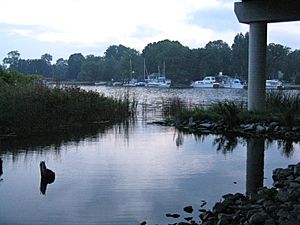Mnjikaning Fish Weirs facts for kids
Quick facts for kids Mnjikaning Fish Weirs |
|
|---|---|
 |
|
| Nearest city | Orillia, Ontario |
| Original use | Harvesting fish |
| Official name: Mnjikaning Fish Weirs National Historic Site of Canada | |
| Designated | 12 June 1982 |
The Mnjikaning Fish Weirs are an amazing example of ancient engineering in Canada. These special fish traps were built by First Nations people a very long time ago. Scientists believe they were built around 2500 BC. That's about 4,500 years before Canada became a country!
These weirs are located in a narrow waterway. This spot is between Lake Couchiching and Lake Simcoe. Today, it's known as Atherley Narrows. A highway, Ontario Highway 12, now crosses over this area. The weirs were kept safe for thousands of years. They were protected by the water and layers of soft mud.
Contents
What Are Fish Weirs?
How They Were Built
The Mnjikaning Fish Weirs were like fences in the water. They were made using strong local wood. Some of the trees used were eastern white cedar, sugar maple, and white birch. These wooden stakes were placed in the water to create the fences.
How They Worked
The weirs were designed to catch fish. Early fishermen would weave branches and plants between the wooden stakes. This made a net-like fence. Fish swimming through the narrows would be guided into these traps. Once trapped, the fish could be caught easily. People used spears or nets to catch them. The fish were important for food, especially during the cold winter months.
A Long History
Ancient Use and Discovery
The Mnjikaning Fish Weirs were used for about 5,000 years. They were active until the early 1700s. This shows how clever and important they were to the people living there. The weirs were known by different names. The Huron people called them ouentaronk. The Mohawk people called them tkaronto.
It's believed that the name for the City of Toronto comes from these weirs. Over time, the name changed slightly. A famous explorer, Samuel de Champlain, saw the weirs. He wrote about them on September 1, 1615. He was traveling with the Huron people at the time.
Protecting This Historic Site
The Mnjikaning Fish Weirs are very important to Canada's history. They were officially named a National Historic Site of Canada on June 12, 1982. This means they are protected and recognized for their special value. The site is looked after by the Rama First Nation. They created a group called the Mnjikaning Fish Fence Circle. This group works to protect the weirs and teach people about them.

